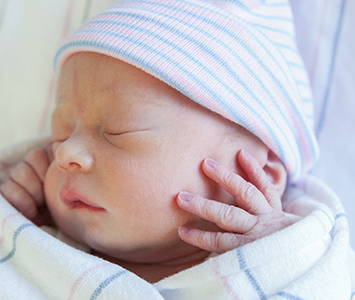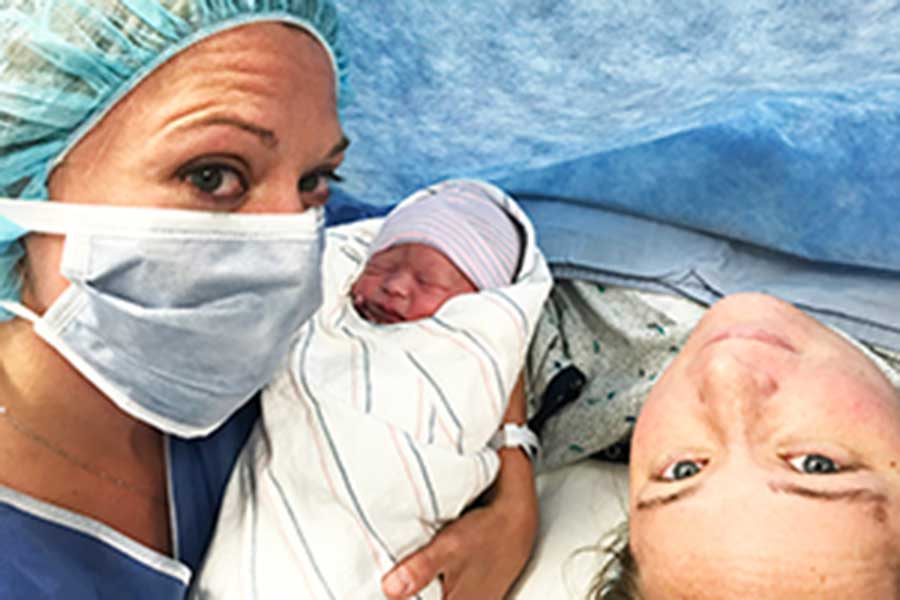In keeping with Jackson’s nursery theme, there’s a line from the final “Harry Potter” movie that has been running through my head the last few weeks: “When have any of our plans ever actually worked? We plan, we get there, all hell breaks loose!”
Jackson made his debut at 6:36 p.m. Aug. 7, born via C-section about three weeks early. If his entrance into this world is any indication of what’s to come, Ashlee and I are in for one hell of a ride — for which no amount of planning will ever prepare us.
Under pressure
On July 31, Ashlee started complaining of a bad headache. Ever the nagging wife, I kept urging her to call her OB/GYN, as headaches can be an early sign of pre-eclampsia, a blood-pressure-related complication about which we had heard horror stories. The next evening she did, and the doctor told her to head straight to triage at our hospital’s labor and delivery unit. I panic-texted a neighbor to see if she could take our dog — since my worst-case-scenario brain had her going into pre-term labor that night — and off we went. Four hours and an IV later, the nurses and midwife sent us home. Ashlee’s blood pressure was elevated, which they said isn’t uncommon late in pregnancy, advising us to notify the doc of any new symptoms.
Lo and behold, the next day brought nausea and another trip to triage. This time, the doctor on call said that as long as her pressure didn’t quickly escalate, they would want to induce early the following week. They wanted Ashlee to make it to 37 weeks (when the baby would be considered full-term), but she had started down the path toward pre-eclampsia, from which they said there’s no turning back. All of a sudden, our meticulously planned timeline sped up by three weeks. We were still washing and putting away clothes from our baby shower four days before — every surface of our house was covered in size-organized onesies. I kept telling Ashlee she couldn’t go yet, as I needed to get the clothes away, seemingly the only thing in our control at that point.
After that particular hospital visit, I stopped at Target for toilet paper and parlayed the stress into unnecessary food shopping (doesn’t everyone need three frozen stuffed-crust pizzas?). The next night, a Friday, it was back to our favorite triage unit after Ashlee almost fainted. The whole weekend, the docs advised us to monitor her blood pressure, so we were driving back and forth to the local Giant (free blood-pressure checks!) every few hours. That Sunday night, we finally put the last folded and washed onesie into Jackson’s drawer.
On Monday morning, Ashlee had an OB appointment and I was obsessively checking my texts while I was at work, sweating bullets, knowing they’d be pulling the trigger soon. I went home at my lunch break to walk the dog and ran into her as she was pulling down the street, leaning out the window to exclaim: “We’re having a baby today!”


It’s go time
I would never want anyone to be stuck in a crisis with me. We had our hospital bags packed and in the car for weeks, but the news that the doctors were inducing Ashlee that day sent me into a tizzy. I tore through the house, throwing things we didn’t need into bags, changing my clothes twice and texting my boss that I wouldn’t be coming back from lunch for two weeks. I’m presuming many couples balance each other out when it comes to crises, and Ashlee calmly waited by the door until I was done my freak-out.
If we thought pregnancy was laden with waiting, we had another thing coming. The doctors cautioned us to buckle in for the long haul, as induction at 37 weeks often takes at least two days. Monday afternoon, since Ashlee was still three weeks early, the doctor inserted a dose of Cytotec to start the dilation process before the IV drip of Pitocin could kick contractions into high gear (since we figured Ashlee would deliver the natural way at the right time, we were ignorant of this process and were furiously Googling all the terms the nurses were casually dropping). The doctors had previously advised us to make a “birth plan” — some expectant parents write out exact instructions for pain medications, who is allowed to be present, what positions they want to be in and a plan for emergent care. Our figurative plan only involved me clamping the umbilical cord, so we felt woefully unprepared all of a sudden.
After 12 hours of light contractions (and less than 45 minutes of sleep for Ashlee), Tuesday morning brought the discouraging news that she had only dilated from 1 cm to 1.5 cm, setting the pace for a frustrating series of stops and starts. A few hours later, the doctors manually broke her water, and the pain came on in a rush (or so she tells me!). After a few hours of watching “Judge Judy” and clutching the bedframe every few minutes as contractions got worse, Ashlee opted for the epidural, and we both held hands and cried as the anesthesiologist unceremoniously jabbed the world’s largest needle into her back. Just when she was starting to accept that she’d be taking up residence in the labor room, a doctor threw us another curveball: It was looking like a C-section may be necessary. Jackson had wedged his hand next to his head (the annoying position he assumed for every single ultrasound we ever had, preventing a clear picture of his face) as he was starting to descend. Two hours later, he had moved his hand completely on top of his head; the doctor laughed that she could shake his little fingers and said “C-section it is!” A whirlwind 15 minutes later, they were wheeling Ashlee down the hall into the OR as I was furiously texting our family members to beeline it back to the hospital and then donning scrubs.
In the moment, it felt like the floor was falling out from beneath me. My wife was being prepared to be sliced open, the baby we had envisioned for years would be here in seconds and we had no time to gear up. In hindsight, I’m glad it happened in such a rush, as neither of us had time to succumb too much to nerves — and we were given our first taste of a reality we’ve since accepted: With parenthood, you often have to just roll with things.
A half-hour before, I had been planning what dinner to get from the cafeteria, and here I was holding Ashlee’s hand with a curtain draped in front of us as the doctors casually chatted over her open stomach. At a certain point, a nurse told me to stand up and get my camera ready and, terrified of the gore I would face, I reluctantly looked down to see them pulling a melon-looking object out of Ashlee’s stomach. Which organ is that? I wondered before I snapped out of it and realized that was Jackson’s head, and I jumped into paparazzi mode. He started wailing and we started crying.
A few seconds later, the nurses wrapped up this wriggling little being in a blanket and whisked him back for us to see, the most surreal moment of both of our lives. Even though we knew on a cognitive level that there was a tiny being in there causing her belly to grow for nine (well, more like eight) months, seeing that he was a living, breathing (screaming!) real person was hard to actually wrap our brains around. I would guess that this is an experience that transcends sexual orientation, gender identity, race, age and so many other barriers; the first time you see your child — no matter how they’re conceived or brought into this world — is, as clichéd as it may sound, life-changing.
Thankfully, the doctors and nurses were well trained in how to manage such an emotional situation. With practiced hands, they weighed Jackson, taking bets among themselves at his weight, all of them overshooting his tiny 5 pounds, 4 ounces. The medical staff gushed at how adorably small he was and offered to take the first pictures of us as a family. It was heartening that they were congratulating us on “our” son so seamlessly, which I think speaks to a profession where extraneous factors such as sexual orientation often seem inconsequential in light of literal life-or-death situations.
That idea came front and center in the coming days. Despite all of our preparation, we quickly saw that we didn’t know the first thing about taking care of an infant — but what we did know was that he was healthy and Ashlee was on the mend, and that was all that mattered.
The lessons we’re learning every day — practically every minute — are showing us to toss the guidebooks and the outlines, and instead just follow where the unparalleled love we have for this little guy tells us to go.
